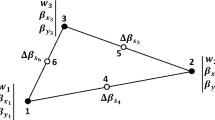This study proposes a new numerical-and-analytical method for solving geometrically nonlinear problems of bending of complex-shaped plates made of functionally graded materials developed. The problem was formulated within the framework of a refined higher-order theory considering the quadratic law of distribution of transverse tangential stresses along the plate thickness. To linearize the nonlinear problem, we used the method of continuous continuation in the parameter associated with the external load. For the variational formulation of the linearized problem, a Lagrange functional was constructed, defined at kinematically possible displacement velocities. To find the main unknowns of the problem of nonlinear plate bending (displacements, strains, and stresses), the Cauchy problem for a system of ordinary differential equations is formulated. The Cauchy problem was solved by the Runge-Kutta–Merson method with automatic step selection. The initial conditions are found from the solution of the problem of geometrically linear deformation. The right-hand sides of the differential equations, at fixed values of the load parameter corresponding to the Runge-Kutta–Merson scheme, were obtained from the solution of the variational problem for the Lagrange functional. The variational problems were solved by the Ritz method in combination with the R-function method. The latter makes it possible to present an approximate solution as a formula. This solution structure exactly satisfies all (general structure) or part (partial structure) of the boundary conditions. Test problems are solved for a homogeneous rigidly fixed and functionally graded hinged square plate subjected to a uniformly distributed load of varying intensity. The results for deflections and stresses obtained by the developed method are compared with the solutions obtained by radial basis functions. The problem of bending of a functionally graded plate of complex shape is solved. The influence of the gradient properties of the material and geometric shape on the stress-strain state is investigated.





Similar content being viewed by others
References
J. N. Reddy, “Analysis of functionally graded plates,” Int J Numer Meth Eng, 47, 663–684 (2000).
H. S. Shen, Functionally Graded Materials. Nonlinear Analysis of Plates and Shells, CRC Press, Florida (2009).
H.-T. Thai and S.-E. Kim, “A review of theories for the modeling and analysis of functionally graded plates and shells,” Compos Struct, 128, 70–86 (2015).
A. S. Volmir, Flexible Plates and Shells [in Russian], Gosteorizdat, Moscow (1956).
E. Reissner, “On the theory of bending of elastic plates,” J Math Phys, 23, 184–191 (1944).
Y. Urthaler and J. N. Reddy, “A mixed finite element for a nonlinear bending analysis of laminated composite plates based on FSDT,” Mech Adv Mater Struc, 15, 335–354 (2008).
A. O. Rasskazov, I. I. Sokolovskaya, and N. A. Shulga, Theory and Calculation of Layered Orthotropic Plates and Shells [in Russian], Vyshcha Shkola, Kiev (1986).
J. N. Reddy, “A simple higher-order theory for laminated composite plates,” J Appl Mech, 51, 745–752 (1984).
J. N. Reddy, “Refined nonlinear theory of plates with transverse shear deformation,” Int J Solid Struct, 20, 881–896 (1984).
M. Talha and B. N. Singh, “Static response and free vibration analysis of FGM plates using higher order shear deformation theory,” Appl Math Model, 34, 3991–4010 (2010).
K. J. Bathe and E. L. Wilson, Numerical Methods in Finite Element Analysis, Prentice-Hall, Englewood Cliffs, NJ (1976).
M. L. Bucalem and K. J. Bathe, “Finite element analysis of shell structures,” Arch Comput Method E, 4, 1, 3–61 (1997).
V. L. Rvachev, Theory of R-Functions and Some of Its Applications [in Russian], Naukova Dumka, Kiev (1982).
L. V. Kurpa, E. I. Lyubitskaya, and I. O. Morachkovskaya, “Geometrically nonlinear bending of functionally graded plates on an elastic base,” Visnyk Dnipropetrovsk Univ., Ser. Mechanics of Non-Homogeneous Structures, Issue 2 (21), 77–88 (2017).
N. V. Smetankina, A. N. Shupikov, S. Yu. Sotrikhin, and V. G. Yareschenko, “A noncanonically shape laminated plate subjected to impact loading: Theory and experiment,” J Appl Mech, 75, No. 5, 051004-1–051004-9 (2008).
S. M. Aizikovich, V. M. Aleksandrov, A. S. Vasiliev, et al., Analytical Solutions of Mixed Axisymmetric Problems for Functionally Graded Media [in Russian], Fizmatlit, Moscow (2011).
X. Zhao and K. M. Liew, “Geometrically nonlinear analysis of functionally graded plates using the element-free kp-Ritz method,” Comput Meth Appl Mech Eng, 198, 2796–2811 (2009).
E. I. Grigolyuk and V. I. Shalashilin, “Method of continuation in parameter for problems of nonlinear deformation of rods, plates, and shells,” in: Studies in the Theory of Plates and Shells [in Russian], Issue 17, No. 1, Kazan (1984), pp. 3–58.
K. Washizu, Variational Methods in Elasticity and Plasticity, Pergamon Press (1982).
V. I. Krylov, V. V. Bobkov, and P. I. Monastyrnyi, Computational Methods [in Russian], Nauka, Moscow (1977).
V. N. Van Do and C.-H. Lee, “Nonlinear analyses of FGM plates in bending by using a modified radial point interpolation mesh-free method,” Appl Math Model, 57, 1–20 (2018).
Author information
Authors and Affiliations
Corresponding author
Additional information
Translated from Problemy Mitsnosti, No. 5, pp. 63 – 74, September – October, 2023.
Rights and permissions
Springer Nature or its licensor (e.g. a society or other partner) holds exclusive rights to this article under a publishing agreement with the author(s) or other rightsholder(s); author self-archiving of the accepted manuscript version of this article is solely governed by the terms of such publishing agreement and applicable law.
About this article
Cite this article
Sklepus, S.M. Numerical-and-Analytical Method for Solving Geometrically Nonlinear Bending Problems of Complex-Shaped Plates from Functionally Graded Materials. Strength Mater 55, 927–936 (2023). https://doi.org/10.1007/s11223-023-00583-8
Received:
Published:
Issue Date:
DOI: https://doi.org/10.1007/s11223-023-00583-8




